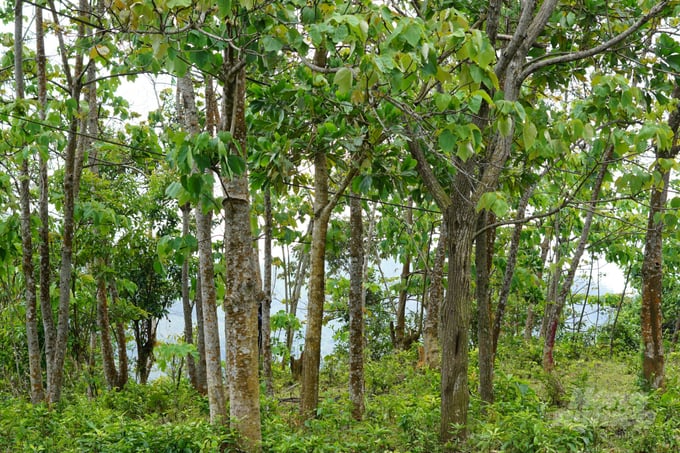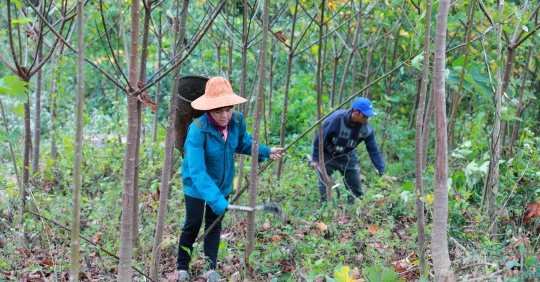Trust for oil is well developed in Quang Tri mountainous region
In 2019, in Malay Pun Village, Huong Phung Municipality, Huong Hoa District, Mr. Ho Van Thon was assisted by the Health Commission of the Netherlands – Vietnam (MCNV) to convert 4 ha of inefficient coffee to grow tea tree for oil. At this point the truffle tree has begun to bear fruit.

After 3 years of planting, Trau has started to produce Divination. Picture: vd
According to Mr. Thon, trau is a native plant, but mainly grows scattered in the forest, is often spontaneously exploited and sold to traders for VND 8-10,000/kg. After 3 years of concentrated sowing, his family’s oleander has grown well and promises high productivity and yield.
“As much as the people can exploit in the forest, the traders will buy it. Now the coffee tree is old and the tree has fallen in price so my family planted 4 hectares with support. If the truffle tree has sustainable value, my family will move the remaining 2 hectares to grow trau for oil,” Thon said.
According to Mr. Thon, the project implementation unit promises to buy all the products before planting. Therefore, in Huong Phung Township, there are many households that cultivate trau for oil.
Ha Ngoc Duong, vice chairman of the Huong Phung Municipality People’s Committee, said that from 2019 to now, the Dutch-Vietnamese Health Commission has assisted people to plant 180 ha of Trau Trau oil in the municipality. Between the orchards for oil, there is a 30% intercropping of longan core trees. In addition, people have scattered about 10 ha. In general, the Traubaum is suitable for the local soil conditions.
According to the survey, at present, Huong Phung still has many areas that can be converted to grow trau for oil, especially the area on high hills, which is not suitable for traditional crops such as coffee, cassava…. It is very good to convert this area to grow tea for oil. However, it is important to have a place to grow it so that people can consume it,” Duong said.

Currently, Huong Phung Municipality has 180 hectares of concentrated cultivation, with 30% of the core trees being grown in intercropping. Picture: vd
According to statistics, the two districts of Huong Hoa and Dakrong (Quang Tri) have nearly 2.95,000 hectares of weeping forest, of which nearly 2.7,000 hectares are concentrated planted, 98% of the area has been harvested, and many cultivated areas. High and stable yield. Products of trau tree consumed in the market are mainly trau nut, with a total production of about 1,000 tons/year, most of which are exported to the Chinese market.
However, the current harvesting and pre-processing of trau fruit in Quang Tri Province is mainly spontaneous, fragmented, manual, without processing facilities, which affects the sustainability of the forest.
Over 16 billion dongs have been invested in raw material extraction
The Quang Tri Provincial People’s Committee has just released a plan to develop production-related processing and consumption of trau oil in the region for the period from 2023 to 2026, with a focus on 2030.
According to the plan, Quang Tri province will invest VND16.26 billion in the period 2023-2026 to develop the concentrated tea-growing areas in Huong Hoa and Dakrong districts. The financing from the budget and programs and projects is VND 13.53 billion, the mobilized capital is VND 2.73 billion.

The rice bowl project was successful, but people were concerned about the output for the product. Picture: vd
The goal of Quang Tri is to develop Trau Trau in a stable and long-term direction, to form a concentrated and reasonable production of raw materials and commodities in conjunction with a processing plant and a market for the consumption of Trau Trau. In parallel with the development of the area, this place will build a brand name, add value to products from the Trau tree, improve the production value of forestry and contribute to the improvement of forest cover, and improve life in the highland people.
In the period from 2023 to 2026, Quang Tri will protect and stably maintain nearly 2.95,000 hectares of the existing Trau forest and improve the quality, targeting a fresh fruit yield of 3 tons/ha or more; Added value of the Trauwald increased by 20% or more compared to today, show high profitability, ensure the protective function of the forest. The area of fruit forest with a certificate of sustainable forest management reached over 1,000 hectares during this period.
By 2030, Quang Tri will form a concentrated raw material area of about 8.32 thousand hectares and annually supply 4 thousand tons of high-quality trau nut for pre-processing, processing and export. The area of acacia forest with a certificate of sustainable forest management reaches 5,000 hectares or more; At least 2,000 households participate in the planting and development of tea trees.

If the plan is successful, thousands of families in Huong Hoa and Dakrong districts will benefit. Picture: vd
In order to improve the quality of Trau forests, Quang Tri will build breeding nurseries, select varieties with at least 15% higher yield, high quality and at least 5% better oil content compared to mass production. To implement the plan to develop 5,000 ha of concentrated material land, Quang Tri will plant 500 ha every year and annually supply 2,000 tons of trau nut for pre-processing, processing and export.
Preparatory and processing plants in connection with raw material areas towards modernity with an average capacity of 500 – 1,000 tons/year were formed and built to serve domestic consumption and export.
This plan will help at least 1,000 families get involved, create more jobs and increase Chau’s income to reach at least 15% of household economy. Cultivating shells for oil will create stable seasonal jobs for people, help build new rural areas, reduce poverty, and ensure national defense and border security.
Trau is a medium-sized, versatile, fast-growing tree with high utility and economic value, which can meet the need for raw materials in the shortest possible time and will soon provide a steady income for the family. Helping people improve their lives, eliminate hunger and reduce poverty while helping to green bare lands and barren hills and meet forest conservation requirements.

